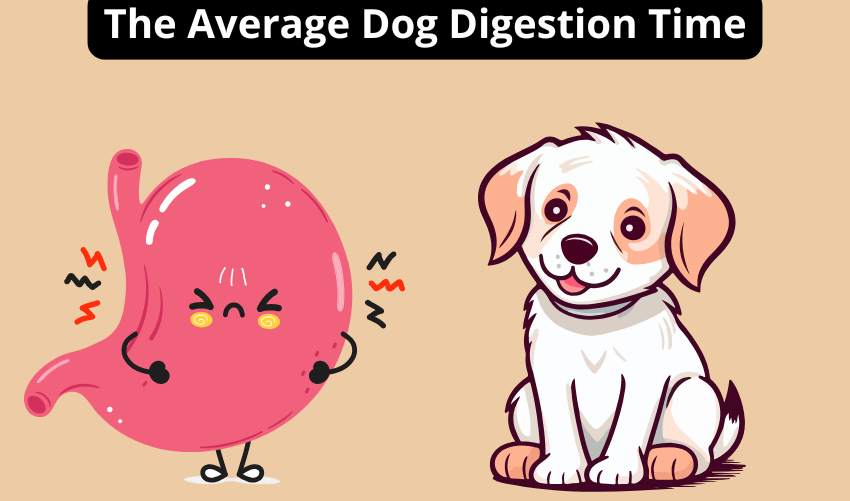Every dog is different. Some dogs may digest food quickly, while others take longer. Factors like breed, age, and diet all play a role in this process.
By exploring the average digestion time and its influences, you can ensure your dog stays healthy and happy.
Understanding Canine Digestion From Start To Finish
Food is broken down by chewing and saliva before reaching the stomach. This initial phase is vital for proper digestion.
Dogs use their teeth to tear and chew food, making it easier for the stomach to process. Saliva contains enzymes that begin breaking down carbohydrates.
Key steps in this stage:
- Chewing: This mechanical action breaks food into smaller pieces.
- Saliva Production: Saliva moistens food and contains digestive enzymes.
- Swallowing: The tongue pushes food down the esophagus to the stomach.
The time spent in the mouth varies based on the type of food and the dog’s eating habits.
Stomach To Small Intestine: The Core Of Digestion
In the stomach, food mixes with gastric juices. This acidic environment helps dissolve food and kill harmful bacteria. Here’s where most nutrient absorption happens over several hours. The stomach churns food, turning it into a semi-liquid form called chyme.
Key functions during this stage:
- Mixing: Stomach muscles mix food with digestive juices.
- Acidic Breakdown: Strong acids break down proteins and kill bacteria.
- Controlled Release: Chyme is released into the small intestine gradually.
The small intestine is where the magic happens. It consists of three parts: the duodenum, jejunum, and ileum. Each part plays a role in nutrient absorption.

The Final Stretch: Large Intestine And Elimination
The last part of the digestive process occurs in the large intestine. Here, water is absorbed and waste is formed for excretion. Its main job is to extract water from indigestible food matter.
Important aspects of this stage include:
- Water Absorption: Helps maintain hydration and consistency of waste.
- Formation of Waste: Leftover material is compacted into feces.
- Excretion: Waste is stored until it is expelled from the body.
The time food spends in the large intestine varies. Typically, it ranges from 12 to 30 hours. Factors like diet, hydration, and individual health can influence this time.
Average Digestion Times By Dog Size And Breed
Smaller dogs tend to digest food faster than larger breeds. Factors like diet, metabolism, and activity levels also play a significant role.
Small Breeds: Fast And Efficient
Small breed dogs are known for their quick digestion. They often process food in a shorter time compared to larger breeds. Smaller dogs may digest meals in as little as 4–6 hours.
- Examples of small breeds include:
- Chihuahuas
- Pomeranians
- Dachshunds
These dogs tend to eat smaller meals more frequently throughout the day. Their quick digestion helps them maintain energy levels.
Medium Breeds: The Middle Ground
Medium-sized breeds offer a balance in digestion times. For these dogs, digestion takes roughly 8–10 hours depending on their diet and metabolism.
| Medium Breed | Average Digestion Time |
|---|---|
| Beagle | 8-9 hours |
| Bulldog | 8-10 hours |
| Cocker Spaniel | 8-10 hours |
These breeds often require two meals per day. A balanced diet is crucial for their health. Foods rich in fiber can aid digestion. Owners should pay attention to any signs of digestive upset.
Large Breeds: Slower And Longer Process
Large breeds have a slower digestion process. Big dogs can take 10–12 hours or more to fully digest food. Their larger stomachs and slower metabolism contribute to this longer time.
| Large Breed | Average Digestion Time |
|---|---|
| German Shepherd | 10-12 hours |
| Labrador Retriever | 10-12 hours |
| Great Dane | 12 hours or more |
These dogs usually eat larger meals less frequently. It’s important to monitor their food intake. Overeating can lead to health issues like bloat.

Key Factors That Influence Digestion Time
The average dog digestion time varies. Many factors influence how quickly a dog digests food. Below, we explore the key factors that affect digestion time.
Type Of Food: Kibble Vs. Raw Vs. Wet
Dogs eat different types of food. Each type affects digestion time in unique ways.
- Kibble: Dry food takes longer to digest. It needs more time to break down in the stomach.
- Raw Food: Raw diets are often easier to digest. They contain natural enzymes that aid digestion.
- Wet Food: Wet food is softer and moist. It is digested more quickly than dry food.
Here’s a table showing the average digestion times for different food types:
| Type of Food | Average Digestion Time |
|---|---|
| Kibble | 8-12 hours |
| Raw Food | 4-6 hours |
| Wet Food | 3-5 hours |
Choosing the right food type helps manage digestion times. Owners should consider their dog’s needs and preferences.
Activity Level: Active Vs. Sedentary Dogs
The activity level of a dog greatly affects digestion. More active dogs may have faster metabolisms and digestion rates. Regular exercise helps speed up digestion.
In contrast, sedentary dogs may experience slower digestion. Lack of movement can lead to a sluggish metabolism. This can cause food to sit longer in the stomach.
- Active Dogs: Require more calories. Their bodies work faster, leading to quicker digestion.
- Sedentary Dogs: May gain weight if not exercised. Their slower digestion can lead to health issues.
Finding the right balance in activity level is crucial. Owners can help their dogs by incorporating regular play and walks. This keeps their metabolism healthy.
Age And Health Status: Puppies, Adults, And Seniors
A dog’s age and health status play important roles in digestion. Younger dogs, like puppies, digest faster than older dogs. Their bodies are still growing and developing.
Adult dogs have a stable digestion rate. They usually digest food at a normal pace. Senior dogs may face challenges. Medical issues can slow things down.
- Puppies: Fastest digestion; they need energy for growth.
- Adult Dogs: Normal digestion; maintains energy levels.
- Senior Dogs: Slower digestion; may need special diets.
Monitoring a dog’s health is vital. Regular vet visits ensure any issues are addressed early. Owners should adjust diets according to age and health needs.
Signs Of Healthy Digestion In Dogs
This section discusses two main signs of healthy digestion: normal stool and elimination frequency, along with energy levels and appetite.
Normal Stool And Elimination Frequency
Regular bowel movements are crucial for your dog’s digestive health. Healthy stools indicate that food is being processed correctly. Here are some key points to consider:
- Stools should be firm and well-formed.
- Color should be brown, not too dark or too light.
- Frequency of elimination varies by dog but should generally be 1-3 times a day.
Observing your dog’s bathroom habits can reveal a lot about their digestion. A healthy dog typically produces:
| Type of Stool | Description |
|---|---|
| Normal | Firm, brown, and easy to pick up. |
| Soft | Loose stools that may indicate a dietary issue. |
| Diarrhea | Frequent, watery stools requiring immediate attention. |
Regular, well-formed stools show proper digestion. Changes in stool consistency or frequency can signal issues. Watch for signs of discomfort or straining.
Energy Levels And Appetite
Energy levels and appetite are strong indicators of your dog’s digestive health. A healthy dog should be lively and eager to eat. Look out for these signs:
- Consistent appetite indicates good digestion.
- High energy levels show proper nutrient absorption.
- Engagement in play and activity reflects overall health.
Consistent appetite and alertness suggest good digestive health. Make sure your dog has a balanced diet to support their energy needs.

When Digestion Goes Wrong: Issues To Watch For
When digestion goes wrong, it can lead to discomfort and serious health issues. Recognizing warning signs is key to keeping your dog healthy.
Constipation, Diarrhea, And Bloating
Digestive issues in dogs can lead to discomfort, health problems, and even emergencies. Knowing the signs early helps you act quickly and protect your dog’s well-being.
1. Constipation
What It Looks Like:
- Straining while trying to defecate
- Hard, dry stools
- Fewer bowel movements than usual
Common Causes:
- Low-fiber diet
- Dehydration
- Lack of physical activity
2. Diarrhea
What It Looks Like:
- Frequent trips outside
- Loose or watery stools
- Urgency to defecate
- Possible blood or mucus in stool
Common Causes:
- Sudden dietary changes
- Food allergies or intolerances
- Infections or parasites
- Poor-quality food
3. Bloating (Gastric Dilation and Volvulus – GDV)
This is a medical emergency. Seek immediate veterinary attention if symptoms occur.
What It Looks Like:
- Swollen, tight abdomen
- Visible discomfort or restlessness
- Unproductive attempts to vomit
- Excessive drooling
Possible Causes:
- Eating too quickly
- Swallowing air during meals
- Exercise right after eating
- Genetic predisposition (common in large breeds)
Monitoring your dog’s behavior is crucial. Changes in eating habits or energy levels can indicate underlying problems. Consult a veterinarian if you notice persistent issues.
Tips To Support Better Digestion In Dogs
Tips to support better digestion in dogs can lead to improved health. A well-balanced diet and proper hydration are essential for a happy, healthy dog.
Feed Consistent, High-quality Meals
Feeding your dog high-quality meals is crucial. Select food with easily digestible ingredients. This helps the digestive system work smoothly. Stick to a schedule for feeding times.
- Choose dog food with natural ingredients.
- Avoid fillers like corn and soy.
- Look for proteins like chicken or fish.
- Include vegetables for fiber.
Check the feeding guidelines on the dog food packaging. Adjust portions based on your dog’s size and activity level. Consider a table for better understanding:
| Dog Size | Daily Food Amount (cups) |
|---|---|
| Small (under 20 lbs) | 1/2 to 1 cup |
| Medium (20-50 lbs) | 1 to 2 cups |
| Large (50-100 lbs) | 2 to 4 cups |
High-quality meals can lead to better digestion. Dogs thrive on food that nourishes their bodies.
Add Probiotics And Digestive Enzymes
Probiotics and digestive enzymes can improve your dog’s gut health. These can support gut health and smoother digestion. Probiotics introduce good bacteria to the digestive system.
- Choose probiotic supplements made for dogs.
- Look for options that contain live cultures.
- Digestive enzymes can be added to meals.
- Consult your vet for suitable products.
Incorporating these supplements can lead to noticeable improvements. Dogs may experience less bloating and more regular bowel movements. A healthy gut can also strengthen their immune system.
Keep Hydration Levels Up
Hydration is vital for good digestion. Water helps with food breakdown and nutrient absorption. Always provide fresh, clean water for your dog. Encourage them to drink regularly.
- Replace water daily.
- Use a bowl that is easy to access.
- Consider a water fountain to encourage drinking.
- Monitor their water intake, especially in hot weather.
Dehydration can cause digestive issues. Dogs may suffer from constipation or other health problems without enough water. Aim for a consistent water supply to support their overall health.


